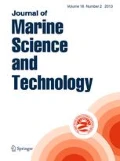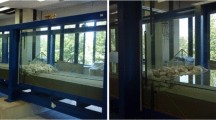Abstract
Experimental tests on the interaction between waves and a submerged rubble-mound breakwater (SBW) were performed in the wave flume at the Institute of Hydroengineering PAS in Gdańsk (Poland). A model of a submerged breakwater was prepared based on the constructions built in 2006 in the Polish zone of the Baltic coast, in Gdańsk Bay, in the region of Gdynia Orłowo (Orłowo Cliff). The tests were carried out for regular waves (varying parameters: height, period, length, and steepness) whose parameters were determined on the basis of the actual wind field occurring in Gdańsk Bay. The experiment was conducted for two water levels corresponding to the actual long-term mean sea level (msl) of 500 cm as well as a storm surge of 550 cm. The research has focused on the analysis of the amount of wave energy transmitted into the lee region and the determination of parameters that affect the transmission size. Types of wave-breaking were described based on the extensive video and photographic documentation prepared during the measurements. Based on the results obtained from the experiment and the previous research on the functioning of submerged breakwaters in the coastal zone, including both numerical modelling as well as field research and field observations, the efficiency of the structure was assessed.









Similar content being viewed by others
References
Basiński T, Pruszak Z, Tarnowska M, Zeidler R (1993) Seashores protection. Publisher Institute of Hydroengineering PAS, Gdańsk (in Polish)
Creter RE, Garaffa TD, Schmidt CJ (1994) Enhancement of beach fill performance by combination with an artificial submerged reef system. In: Tait LS (ed) Proceedings of 7th National Conference on Beach Preservation Technology, Florida Shore and Beach Preservation Association, Tallahassee, Florida, 9–11 February 1994, pp 69–89
Cáceres I, Sánchez-Arcilla A, Alsina JM, González-Marco D, Sierra JP (2006) Coastal dynamics around a submerged barrier. In: Sanchez-Arcilla A (ed) Coastal dynamics 2005: State of Practice, ASCE, pp 1–14
Cruz EC, Aono T (1998) Wave and current fields around gapped submerged breakwaters. J Hydraul Coastal Environ Eng JSCE 586/II-42:127–135
Penchev V (2005) Interaction of waves and reef breakwaters. In: Zimmermann C, Dean RG, Penchev V, Verhagen HJ (eds) Environmentally friendly coastal protection, NATO science series: IV: earth an environmental sciences, vol 53, chapter 1. Springer, Netherlands, pp 107–127
Van der Meer JW, Briganti R, Zanuttigh B, Wang B (2005) Wave transmission and reflection at low-crested structures: design formulae, oblique wave attack and spectral change. Coast Eng 52:915–929. doi:10.1016/j.costaleng.2005.09.005
Armono HD, Hall KR (2003) Laboratory study of wave transmission trough hemispherical hollow artificial reefs. In: Proceedings of Canadian Coastal Engineering Conference, Canadian Society for Civil Engineering, Kingston, Canada, 2003
Stauble DK, Tabar JR (2003) The use of submerged narrow-crested breakwaters for shoreline erosion control. J Coastal Res West Palm Beach (Florida) 19(3):684–722
Wamsley T, Hansen H, Kraus NC (2002) Wave transmission at detached breakwaters for shoreline response modelling, vol 14, Tech. Note, ERDC/CHL CHETN-II-45, U.S. Army Engineer Research and Development Centre, Vicksburg, Mississippi
Goda Y, Takada N, Monya Y (1967) Laboratory Investigation of Wave Transmission over Breakwaters, Report of the Port and Harbour Research Institute, no. 13
Dattatri J, Raman H, Shankar NJ (1978) Performance characteristics of submerged breakwaters. In: Proceedings of 16th Coastal Engineering Conference, ASCE Hamburg, Germany, 27 August–3 September 1978
Seelig WN (1980) Estimation of wave transmission coefficients for overtopping of impermeable breakwaters, CERC Coastal Engineering Technical Aid 80-7, December 1980
Van der Meer JW (1990a) Data on wave transmission due to overtopping, Technical Report, Delft Hydraulic, Report n.H986
Van der Meer JW (1990b) Low crested and reef breakwaters, Technical Report, Delft Hydraulic, Report n.H986 II
Van der Meer JW (1991) Stability and transmission at low crested structures, Technical Report, Delft Hydraulic Publication, Report n.H453
Van der Meer JW, Daemen IFR (1994) Stability and wave transmission at low crested rubble mound structures. J Waterw Port C ASCE 1:1–19
d’Angremond K, Van der Meer JW, de Jong RJ (1996) Wave transmission at low crested structures. In: Proceedings of 25th International Conference on Coastal Engineering, Orlando, Florida, 2–6 September 1996
Seabrook SR, Hall KR (1998) Wave transmission at submerged rubble mound breakwaters. In: Proceedings of 26th International Conference of Coastal Engineering, ASCE, Copenhagen, Denmark, 22–26 June 1998
Sildharma IGB, Hall K (2003) Diffraction effect on wave transmission at submerged breakwaters. In: Canadian Coastal Conference ‘03, Queen’s University, Kingston, Ontario, Canada, 15–17 October 2003
Penchev V, Scheffermann J, Shukrieva S, Zimmermann C (2007) Evaluation of Reef Breakwater Efficiency by Physical and Numerical Simulations, Annual Book Franzius Institute, vol 92, January 2007
Vanlishout V, Verhagen HJ, Troch P (2010) Oblique wave transmission through rough impermeable rubble mound submerged breakwaters. In: Smith JM, Lynett P (eds) Proceedings of 32nd Conference on Coastal Engineering, vol 32, no (1), Shanghai, China, pp 255–264
Prabisha PR, Jyothis T (2011) Wave reflection and transmission characteristics of gabion and rubble mound breakwaters. In: National Technological Congress, College of Engineering Trivandrum, Kerala, 28–29 January 2011
Boniecka H, Cieślak A, Dubrawski R, Marcinkowski T, Zawadzka-Kahlau E (2004) Condition identification, risk assessment and proposals for seashore protection of the Gulf of Gdańsk in the section 80.8–81.8 km in Gdynia—Orłowo. Typescript, Maritime Office in Gdynia, September 2004 (in Polish)
Łęczyński L, Kubowicz-Grajewska A (2013) Study case: Orłowo Cliff. In: Łabuz T (ed) Coastal protection methods and their impact on the natural environment of the polish coastal zone of the Baltic Sea. Report, WWF Poland, Warsaw, pp 152–161 (in Polish)
Marcinkowski T, Szmytkiewicz M (2013) Performance of submerged breakwaters as improvement of beach fill effectiveness in Gdynia, Poland. In: Conley DC, Masselink G, Russel PE, O’Hare TJ (eds) Proceedings of 12th International Coastal Symposium (Plymouth, England), Journal of Coastal Research, Special Issue, 65, pp 326–331
Kubowicz-Grajewska A (2015) Morpholithodynamical changes of the beach and the nearshore zone under the impact of submerged breakwaters—a case study (Orłowo Cliff, the Southern Baltic). Oceanologia 57(2):144–158
Krylov YM (1966) Spectral methods of studying and predicting of wind waves. Gidrometeoizdat, Leningrad
Deltares (2010a) Delft3D-WAVE. Simulation of short-crested waves with SWAN—User Manual. Version 3.04, rev. 11114. Deltares, Delft, The Netherlands
Deltares (2010b) Delft3D-FLOW. Simulation of multi-dimensional hydrodynamic flow and transport phenomena, including sediments—User Manual. Version 3.04, rev. 11114. Deltares, Delft, The Netherlands
Puzyrewski R, Sawicki J (1998) Basis of fluid mechanics and hydraulics, 2nd edn. Scientific publishing company PWN, Warsaw (in Polish)
Massel S (1992) Waving on open waters and on limited basins. In: Massel S (ed) Hydraulic engineer guidebook. Maritime publishing company, Gdańsk, pp 38–131 (in Polish)
US Army Corps of Engineers (1984) Shore Protection Manual, Coastal Engineering Research Center, vol 1, Department of the Army Waterways Experiment Stations, Corps of Engineers, Washington DC
Sidek FJ, Wahab MAA (2007) The effects of porosity of submerged breakwater structures on non-breaking wave transformations. Malayas J Civ Eng 19(1):17–25
d’Angremond K, Van Roode FC (2001) Breakwaters and closure dams. Delft University Press, The Netherlands
Ajiwibowo H (2011) 2-D physical modeling to measure the effectiveness of perforated skirt breakwater for short-period waves. ITB J Eng Sci 43(1):57–78
Allsop NWH (1983) Low-crest breakwater. Studies in random waves. In: Proceedings of Coastal Structures’83, ASCE, Arlington, Virginia, USA, 1983
Cokgor S, Kapdasli S (2005) Performance of submerged breakwaters as environmental friendly coastal structures. In: Zimmermann C (ed) Environmentally friendly coastal protection. Springer, Netherlands, pp 211–218
Massel S, Basiński T, Benedyktowska G, Jasińska E, Mazurkiewicz B, Onoszko J, Robakiewicz W (1988) Loads of hydrotechnical structures caused by the marine environment, hydraulic engineer guidebook. Maritime publishing company, Gdańsk (in Polish)
Battjes JA (1974) Surf similarity. In: Proceedings of 14th Coastal Engineering Conference, ASCE, Copenhagen, Denmark, 24–28 June 1974
Cyril J, Jr Galvin (1972) Wave breaking in shallow water. In: Meyer RE (ed) Waves on beaches and resulting sediment transport. Academic Press, New York, pp 413–456
Galvin CJ (1968) Breaker type classification on three laboratory beaches. J Geophys Res 73(12):3651–3659
Dally WR (1989) Quantifying Beach Surfability. In: Proceedings Beach Preservation Technology Conference, Tampa, Florida, 22–24 February 1989
Sayce AJ (1997) Transformation of surfing waves on steep and complex reefs. Master’s thesis, Department of Earth Science, The University of Waikato, Hamilton, New Zealand
Battjes JA (1988) Surf-zone dynamics. Annu Rev Fluid Mech 20:257–293
Peregrine DH (1983) Breaking waves on beaches. Annu Rev Fluid Mech 15:149–178
Calabrese M, Buccino M, Pasanisi F (2008) Wave breaking macrofeatures on a submerged rubble mound breakwater. J Hydroenviron Res 1:216–225. doi:10.1016/j.jher.2007.11.003
Hattori M, Sakai H (1994) Wave breaking over permeable submerged breakwaters. In: Proceedings of the 24th International Conference on Coastal Engineering, ASCE, Kobe, Japan, 23–28 October 1994
Yi-Chun L, Jyun-Han J, Yi-Ping W, Chung-Pan L (2013) Experimental study on wave breaking criteria and energy loss caused by a submerged porous breakwater on horizontal bottom. J Mar Sci Technol 21(1):35–41. doi:10.6119/JMST-011-0729-1
Ranasinghe R, Larson M, Savioli J (2010) Shoreline response to a single shore-parallel submerged breakwater. Coast Eng 57:1006–1017
Lamberti A, Mancinelli A (1996) Italian experience on submerged barriers as a beach defence structures. In: Proceedings of 25th International Conference on Coastal Engineering, ASCE, Orlando, USA, pp 2352–2365
Ranasinghe R, Turner I (2006) Shoreline response to submerged structures: a review. Coast Eng 53:65–79
El-Sharnouby B, Soliman A (2010) Shoreline Response for Long Wide and Deep Submerged Breakwater of Alexandria City, Egypt. In: Proceeding of 26th International Conference, Port Training Institute, Arab Academy for Science, Technology & Maritime Transport, Alexandria, Egypt, 2010
El-sharnouby B, Soliman A (2011) Behavior of shore protection structures at Alexandria, Egypt, During the storm of December 2010. In: Magoon OT, Noble RM, Treadwell DD, Young C Kim (eds) Coast Eng Practice. pp 708–792. doi:10.1061/41190(422)65
Acknowledgments
The author would like to thank the Institute of Hydroengineering PAS (IBW PAN), the Department of Wave Mechanics and Structural Dynamics, the Department of Coastal Engineering and Dynamics, and, in particular, Dr. hab. Eng., Associate Professor of IBW PAN Marek Szmytkiewicz and Assistant Professors: Dr. Eng. Jan Schönhofer and Dr. Eng. Piotr Szmytkiewicz, for their assistance and scientific support. The author thanks the reviewers for their helpful comments, which helped her to improve the manuscript.
Author information
Authors and Affiliations
Corresponding author
About this article
Cite this article
Kubowicz-Grajewska, A. Experimental investigation into wave interaction with a rubble-mound submerged breakwater (case study). J Mar Sci Technol 22, 313–326 (2017). https://doi.org/10.1007/s00773-016-0412-z
Received:
Accepted:
Published:
Issue Date:
DOI: https://doi.org/10.1007/s00773-016-0412-z




